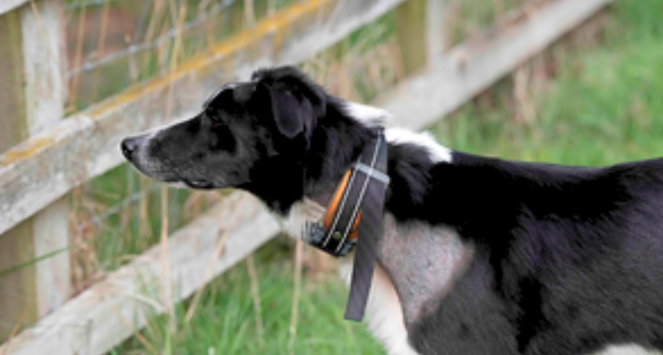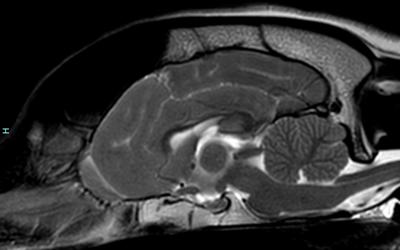
We are pleased to announce that we are once again offering VNS therapy for dogs.
Vagus Nerve Stimulator
What is Vagus Nerve Stimulator (VNS) therapy?
VNS therapy involves using an implant to repeatedly stimulate the vagus nerve. We have previously used a human system for this, but it is no longer available, so we are now using a new canine-specific system.
What does the device look like?
A good description of the device is available on the website of the manufacturer
The system is made up of:
- A small electrode that is placed in contact with the vagus nerve in the neck during a short surgical procedure
- A collar that incorporates a battery pack, control module and induction coil. The induction coil delivers power to the stimulator when needed. The control module can be programmed to deliver stimulations and the desired current and frequency
How does the VNS work to stop seizures?
The control module is programmed to stimulate the vagus nerve at a variable frequency and strength when the coil of the collar is overlying the implant (ie when the dog is wearing the collar)
These impulses are then carried by the vagus nerve to the brain. This regular stimulation alters the neurotransmitter balance in the brain to inhibit generation and spread of seizures. Specifically, it is thought to increase the levels of noradrenaline and serotonin.
This inhibitory neurotransmitter effect is thought to become more pronounced with prolonged stimulation (over weeks to months) but is active immediately too. This means that whilst the repetitive stimulations can decrease the likelihood of seizures, seizures that are just starting might be abolished by stimulation of the vagus nerve too. For this reason, the control module can be activated at the press of a button if a seizure seems imminent.
How effective is it?
We have published the results from the dogs who had the older style of VNS here:
We found that:
- Some dogs cannot tolerate the device (around 1 in 15)
- In dogs who can tolerate the device, seizures start to significantly decrease in frequency after 18-24 months
- After 3-4 years, most dogs had changed from a seizure frequency of more than one per month to none over 6-18 months.
So, we suspect that this is an effective long-term treatment for dogs, but the long time to start to see a positive effect might not make it suitable for all dogs.
Which dogs can have VNS therapy?
Dogs need to be referred by their vet for VNS assessment. We can implant these devices in any dog that can tolerate wearing a collar and has been diagnosed with epilepsy following appropriate confirmation of seizures, blood samples and an MRI (Magnetic Resonance Imaging) scan of the brain.
Because the positive effects can take 18-24 months to appear, VNS therapy is best suited to dogs with a moderately high seizure frequency despite medications (e.g. more than one day with seizures every 3 months) or who are controlled but would like to see if the side effects of their medication can be reduced.
For dogs with more frequent seizures, we would recommend VNS in combination with other changes that we can discuss with clients during their consultation.
What does VNS surgery involve?
We implant the devices under general anaesthetic by making a small incision in the neck and securing the stimulator around the nerve using a silicone strap. Dogs are able to return home on the day of surgery once the devices position has been checked with radiographs.
One big advantage of this system over the previous one is that the stimulation settings can then be altered remotely because the control module is accessible with WiFi.
What happens at the VNS consultation?
First, we offer an in-person or teleconsultation to decide if the therapy is right for you and your dog and that we feel your dog is well enough to have the procedure at that time.
Next, we check how the collar fits onto the dog and that owners are happy with this too because the coil and control module are bulkier than a normal collar. This involves showing demo devices and fitting a collar to them, ideally overnight, to mark the correct position for placement
Once we have done this, we can implant the device and check that it is functional and in the correct position. We will take a CT scan or radiographs to check this.
How much does VNS implantation cost?
The cost is around £4000-4500 depending on whether dogs need an overnight stay or additional blood samples before the procedure. Further rechecks are necessary and can be done remotely. We would expect around 2-3 rechecks costing £120-200 each, which would be dependant on the amount of advice required.
What are the risks and side effects?
The main side effect of VNS implantation is a cough when the device is active. We are able to alter the settings to find the most comfortable current and slowly increase it over time if necessary in most dogs. There are some dogs who do not tolerate this stimulation, but we hope this will be fewer with the new device.
One other important consideration is the reliability of contact between the coil on the collar and the implanted stimulator. If the orientation of the stimulator changes over time, we might lose reliable connection and need to replace the stimulator.
There is a small risk of the stimulator affecting the heart. This occurs in around 1% of humans and is not persistent. The rate is unknown in dogs but has not been observed in the cases previously described.
What happens after VNS surgery?
Once we have placed the device and checked if it is working, dogs can go home with a minimal current being delivered. This will allow us to check the contact between the collar and stimulator at home. Once we are confident that it is working well in the home environment we can start to increase the current up to a therapeutic level.
Can my dog have an MRI scan with a VNS system fitted?
The device may interfere with MRI scans unless certain precautions are taken and not all MRI scanners can do this. If a scan is necessary, we would recommend it before implantation.
How long does the generator last?
We do not have long-term data on this at the moment, but the stimulators have been tested in laboratory conditions that show they should be functional well beyond a normal dog’s lifespan.
Related services
Pet owners need to be referred by their primary care vet.






